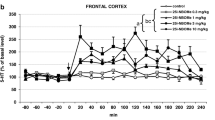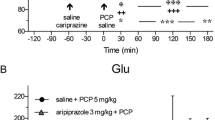Summary
The effects of the benzodiazepine (BDZ) receptor antagonist flumazenil (Ro 15-1788) and the GABAA receptor antagonist bicucuiline on the anticonflict effect observed after depletion of brain serotonin (5-HT), were examined in a modified Vogel's punished drinking conflict model. Pretreatment with para-chlorophenylalanine (PCPA; 300 mg/kg/day for three days, last injection −24 h) markedly decreased brain 5-HT levels and produced clearcut anticonflict effects. The anticonflict effect, but not the biochemical effect, of PCPA pretreatment was completely counteracted by both flumazenil (10 mg/ kg, −30 min) and bicuculline (2.0 mg/kg, −10 min), in doses not altering the behavior per se. The findings suggest a behavioral interaction between 5-HT systems and the GABAA/BDZ chloride ionophore receptor complex, possibly involving a direct neuronal interaction, neuromodulation or hormonal alterations.
Similar content being viewed by others
References
Bonetti EP, Pieri L, Cumin R, Schaffner R, Pieri M, Gamzu ER, Muller RKM, Haefely W (1982) Benzodiazepine antagonist Ro 15-1788: neurological and behavioral effects. Psychopharmacology 78: 8–18
Crawley JN, Glowa JR, Majewska MD, Paul SM (1986) Anxiolytic activity of an endogenous adrenal steroid. Brain Res 398: 382–385
Csanalosi I, Schweizer E, Chase WG, Rickels K (1987) Gepirone in anxiety; a pilot study. J Clin Psychopharmacol 7: 31–33
Engel JA, Hjorth S, Svensson K, Carlsson A, Liljequist S (1984) Anticonflict effect of the putative serotonin receptor agonist 8-hydroxy-2-(di-n-propylamino)tetralin (8-OH-DPAT). Eur J Pharmacol 105: 365–368
Engel JA, Egbe P, Liljequist S, Söderpalm B (1989) Effects of amperozide in two animal models of anxiety. Pharmacol Toxicol (in press)
File SE, Pellow S (1986) Intrinsic actions of the benzodiazepine receptor antagonist Ro 15-1788. Psychopharmacology 88: 1–11
Hjorth S, Söderpalm B, Engel JA (1987) Biphasic effect of L-5-HTP in the Vogel conflict model. Psychopharmacology 92: 96–99
Hunkeler W, Möhler H, Pieri L, Polc P, Bonetti EP, Cumin R, Schaffner R, Haefely W (1981) Selective antagonists of benzodiazepines. Nature 290: 514–515
Kahn RS, van Praag HM, Wetzler S, Asnis GM, Barr G (1988) Serotonin and anxiety revisited. Biol Psychiatr 23: 189–208
Kavaliers M (1988) Inhibitory influences of the adrenal steroid, 3α,5α-tetrahydrodeoxy-corticosterone on aggression and defeat-induced analgesia in mice. Psychopharmacology 95: 488–492
Koe BK, Weissman A (1966) p-Chlorophenylalanine: a specific depletor of brain serotonin. J Pharmacol Exp Ther 154: 499–516
Koe BK, Kondratas E, Russo LL (1987) (3H)Ro 15-1788 binding to benzodiazepine receptors in mouse brain in vivo: marked enhancement by GABA agonists and other CNS drugs. Eur J Pharmacol 142: 373–384
Koenig JI, Gudelsky GA, Meltzer HY (1987) Stimulation of corticosterone and B-endorphin secretion in the rat by selective 5-HT receptor subtype activation. Eur J Pharmacol 137: 1–8
Koob GF, Thatcher-Britton K, Britton DR, Roberts DS, Bloom FE (1984) Destruction of the Locus coeruleus or the dorsal NE bundle does not alter the release of punished responding by ethanol and chlordiazepoxide. Physiol Behav 33: 479–485
Kuemmel B, Beneke M, Krol G, Schoellnhammer G, Spechtmeyer H (1988) Ipsapirone in the treatment of generalized anxiety disorders. Results of a phase II US-multicenter trial. Psychopharmacoloy [Suppl 96], abstract no 33.03.12
Majewska MD, Harrison NL, Schwartz RD, Barker JL, Paul SM (1986) Steroid hormone metabolites are barbiturate-like modulators of the GAA receptor. Science 232: 1004–1007
Olsen RW (1981) GABA-benzodiazepine-barbiturate receptor interactions. J Neurochem 97: 1–13
Söderpalm B, Engel JA (1988) α2-Adrenoceptor antagonists potentiate the anticonflict and the rotarod impairing effects of benzodiazepines. J Neural Transm 76/3 (in press)
Söderpalm B, Hjorth S, Engel JA (1989) Effects of 5-HT1A receptor agonists and L-5-HTP in Montgomery's conflict test. Pharmacol Biochem Behav 32 (in press)
Svensson K (1986) Dopamine autoreceptor antagonists: a new class of central stimulants. Thesis. ISBN 91-7900-078-9
Thiebot MH (1986) Are serotonergic neurons involved in the control of anxiety and in the anxiolytic activity of benzodiazepines? Pharmacol Biochem Behav 24: 1471–1477
Vernikos-Danellis J, Berger PA (1973) Brain serotonin and the pituitary-adrenal system. In: Barchas J, Usdin E (eds) Serotonin and behavior. Academic Press, New York London, pp 173–177
Waterhouse BD, Moises HC, Woodward DJ (1986) Interaction of serotonin with somatosensory cortical neuronal responses to afferent synaptic inputs and putative neurotransmitters. Brain Res Bull 17: 507–518
Author information
Authors and Affiliations
Rights and permissions
About this article
Cite this article
Söderpalm, B., Engel, J.A. Does the PCPA induced anticonflict effect involve activation of the GABAA/benzodiazepine chloride ionophore receptor complex?. J. Neural Transmission 76, 145–153 (1989). https://doi.org/10.1007/BF01578754
Received:
Accepted:
Issue Date:
DOI: https://doi.org/10.1007/BF01578754




